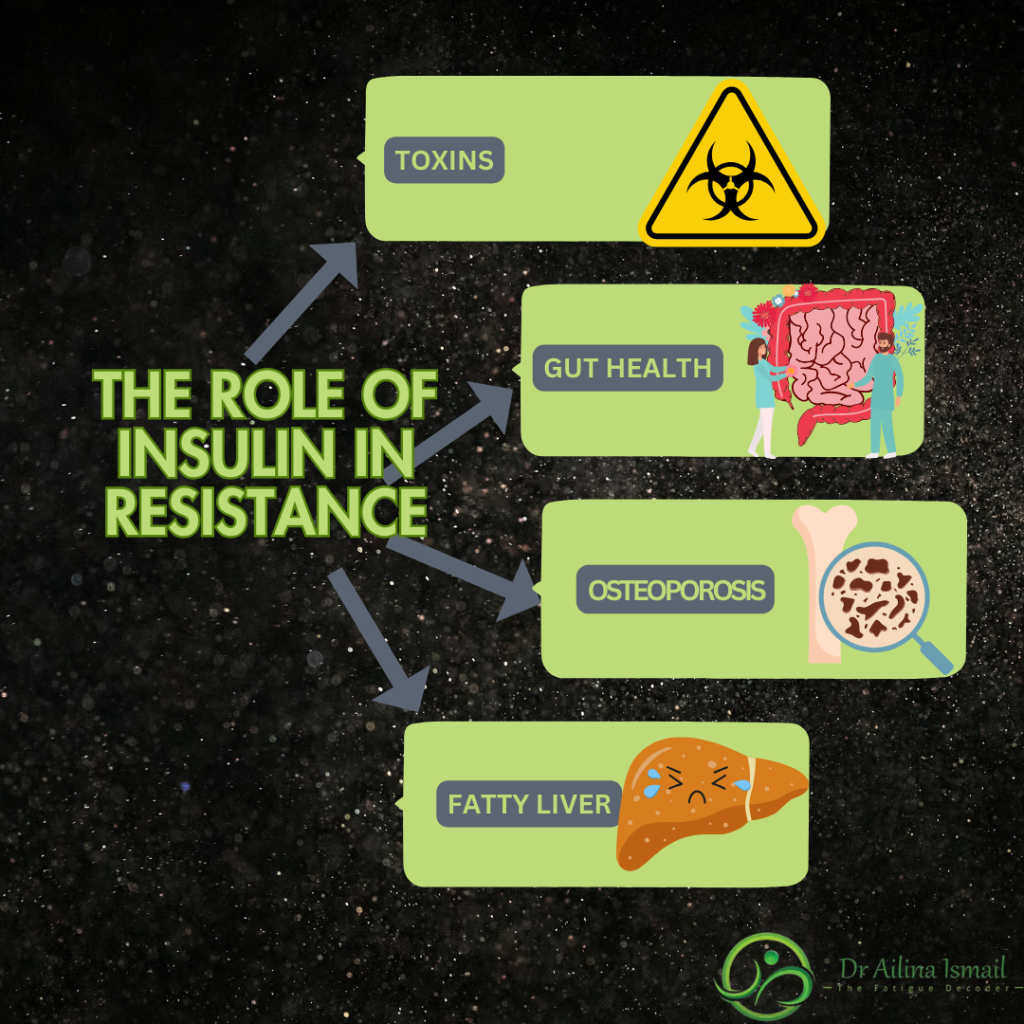(
Insulin resistance is a critical health concern that can significantly impact our overall well-being. It’s essential to explore the various factors contributing to this condition, such as toxins, gut health, bone health, inflammation, and NAFLD (Non-Alcoholic Fatty Liver Disease).
Let us delve into the intricate connection between these elements and their role in insulin resistance.
Toxins: Environmental toxins and pollutants pose a significant threat to our health by disrupting the body’s natural processes, including insulin sensitivity. It’s crucial to be vigilant about our exposure to these toxins and understand how they can contribute to insulin dysfunction.
Individual genes might play a role, but they alone don’t determine the outcome. Genetic predisposition sets the stage, but the environment and lifestyle are the main actors in this play.
When you combine genetic predisposition with a toxic lifestyle or exposure to an environmental “soup” filled with various stressors, that’s when you see a shift in insulin function. This can manifest in different health conditions or phenotypes.
When taking a patient’s history, examining their health, and analyzing lab results, I always keep toxicity exposure in mind. What’s commonly perceived as “normal” or “common” might not be normal at all.
I ask questions about factors like pollution, smoking, endocrine-disrupting chemicals, pesticide exposure, and other environmental influences because these can significantly impact a person’s health.
Remember, just because something happens commonly doesn’t mean it should be considered normal. We aim to dig deeper and unveil the underlying factors that may be contributing to insulin dysfunction.
Gut Health: Our gut is a powerhouse when it comes to our overall health. It plays a more substantial role than we might realize, and an imbalance in gut bacteria or digestive issues can affect how our body processes glucose, potentially leading to insulin resistance.
The composition of the gut microbiome and the type of diet it’s exposed to play a crucial role in this process. What are we feeding our gut ‘bugs’ with? High sugar intake can feed candida and other bad bacteria in our gut.
So, that’s when we need to look at ‘sugar-detox’ or a low-carb diet or even a ketogenic diet would be the common ones. But some people get bogged down by ‘diets’ and after a while, they give up. My simple solution would be – if you had a 9-inch plate, 1/2 of it should be vegetables, 1/4 should be protein, and 1/4 should be carbohydrates. If you wanted to reduce the carbs, then, increasing protein would help a lot in terms of feeling full longer and less ‘hangry’!
Bones: Surprisingly, there’s a remarkable connection between bone health and insulin sensitivity. Conditions like osteoporosis can influence how insulin functions in our bodies.
Fat deposition in bone makes the bone weak, with a high possibility of causing osteoporosis.
This ‘marbling effect’ can also affect other areas like skeletal muscle and the liver (think fatty liver! – see below.)
Inflammation: Chronic inflammation can wreak havoc on our bodies, affecting our response to insulin. Identifying and addressing sources of inflammation is vital in the quest to understand and combat insulin resistance. VAT (Visceral Adipose Tissue) or fat around our organs can cause a lot of inflammation.
AGEs (Advanced Glycation End products…phew! That is a long word!) are compounds formed when sugars chemically react with proteins or lipids in the body. They serve as a significant biological indicator associated with the aging process and the onset or progression of various degenerative conditions, including diabetes, atherosclerosis, chronic kidney disease, and Alzheimer’s disease.
NAFLD (Non-Alcoholic Fatty Liver Disease): Non-Alcoholic Fatty Liver Disease can be a significant contributor to insulin resistance.
Insulin resistance can force fat into places it shouldn’t be, such as our arterial walls, leading to plaque formation and cardiovascular disease.
This process mirrors what happens in non-alcoholic fatty liver disease (NAFLD).
Insulin dysfunction exists on a spectrum, and it can lead to various secondary diseases.
Join our FB community to learn more about managing insulin resistance and improving your overall health. Our Sugar detox challenge is into its final week and will end on Sunday the 12th of November🌿💪
Don’t wait till you are diabetic to address your symptoms.
Work to discover the root causes of insulin resistance, by working through it with a functional medical practitioner who will address your:
- Genetic predisposition
- Mitochondrial dysfunction
- Microbiome imbalance
- Altered body composition
- Environmental Burden
You can start now!
